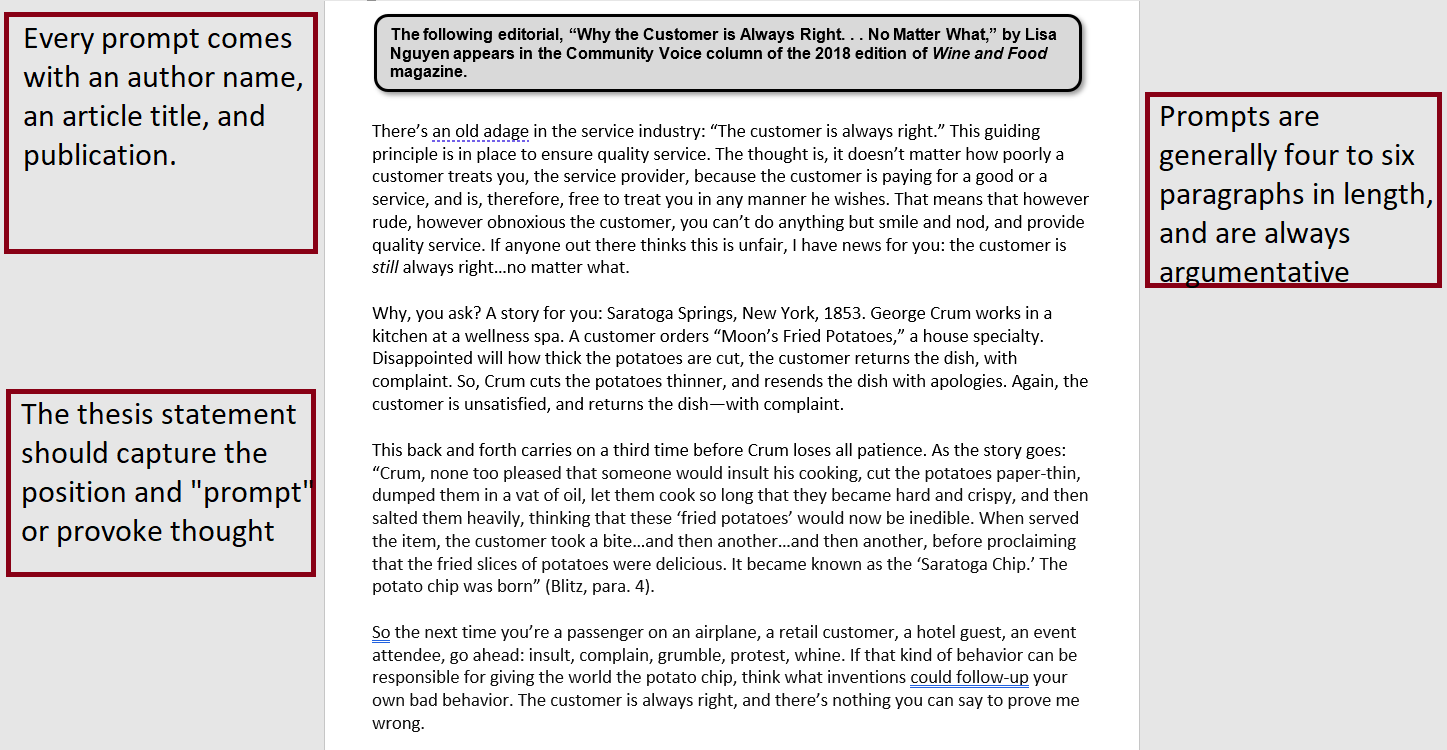The WRIT Curriculum – New Instructor Guide
WRIT Orientation and Key Documents for New Faculty
Welcome to the WRIT Curriculum!!
The WRIT Reason and Writing curriculum at Fanshawe College is a post-admissions course for students whose writing proficiency falls short of college-level standards. Most first-level students at Fanshawe College take a placement assessment for the WRIT course. The evaluation of these assessments allows us to keep the student in—or place them out of—the WRIT course delivered in their program area. The following page will introduce you to the WRIT Curriculum and provide starter resources. This page also stands as a good template for the kind of content that you might want to give students in a blended or fully online delivery of WRIT by utilizing some of the content creation tools in this D2L Learning System(FanshaweOnline).

Meet your Coordinator
Tom Barnes
Email: tbarnes@fanshawec.ca
What’s Here for Me?
Course Plan: Official and Supplementary
The representative course plans below cover a fifteen-week semester:
- WRIT 1030 – Fifteen Week Plan Sample (2022-23)
- WRIT CIS Supplementary Syllabus Sample
- Update the Course Schedule and Due Dates page in FOL to reflect your supplementary syllabus outline. As explained below, you can use this as your supplementary syllabus, direct students to it, and/or create a PDF/WORD version. It’s good to have both!
You can convert the first document above for use in any WRIT section. Download the copy and open it using Adobe Acrobat Pro DC (accessible to anyone with a fanshaweonline.ca email), and hit the “Edit” tab OR you can create your own in WORD and post it as a PDF.
You can change the academic year and add the appropriate course code and section number from there.
You will create a supplementary course plan customized to your specific WRIT section(s) (see below for an example); this supplementary course plan is expected for each of your WRIT sections. It generally contains a breakdown of
- weekly topics and assignments
- course evaluations
- assignment policies
You can complete the topic modules in the order you see most fit. The topic modules under FOL Content in this course are ordered based on the weekly breakdown of the official (or representative) course plan. Following the official (or representative) course plan order may be advisable if you are new to WRIT.
You should cover all the topic modules, but you may spend more or less time than is allotted on any particular topic (i.e., not all of these modules demand precisely three hours of delivery: some need more; some need less; your students will dictate the semester). The topic modules on FOL Content provide a selection of materials and exercises/assignments to choose from and can be modified as needed.
You can schedule your assignments whenever you would like, but the College wants them planned from day one for the students because the Exit Test is in week fourteen; you cannot schedule anything else worth marks during weeks thirteen and fourteen.
Even though seven weeks are earmarked for prompt responses, those are just suggestions on when to offer the SIX total needed for the students to count their FOUR strongest submissions. For instance, the sample supplementary course plan below has scheduled the required total of 6 responses only.
The WRIT Curriculum: FAQS
What is WRIT: Reason and Writing?
The WRIT curriculum at Fanshawe College is a post-admissions course for students whose writing proficiency falls short of college-level standards. Most first-level students at Fanshawe College take a Placement Assessment for the WRIT course. The evaluation of these assessments allows us to keep the student in—or place them out of—the WRIT course delivered in their program area.
What is the Pre-Assessment for WRIT: Reason and Writing?
Most students entering first-level programming at Fanshawe are invited to complete a short read-and-response essay. Students read a five-paragraph position paper (with topics ranging from student life to current affairs) and respond with a five-paragraph essay that a) summarizes the reading and b) critically responds to the reading.
What is the goal of WRIT: Reason and Writing?
The goal of the curriculum is primarily to strengthen students’ critical reasoning and writing skills. The course also has the more focused goal of bringing student writing skills up to the level of “place-out” by the end of the term. We focus on four broad, categorical skill sets:
- Content—strength of argument/depth of argumentative thought
- Organization—the strength of planning, paragraph sequence, and structure
- Style—strength of transitions, formality of voice
- Mechanics—power of articulation, grammar, syntax, structure
What are the Major Assignments for WRIT: Reason and Writing?
- Students complete SIX prompt responses (thus repeating the action of the intake assessment) over the semester; their FOUR strongest efforts count for 50% of the grade (12.5% each).
- Students complete an EXIT TEST, which again continues the actions of the pre-assessment. The EXIT TEST is worth 25%.
- The final 25% remains up to the professor but generally includes scaffolded, skills-based, low-stakes, face-to-face activities.
Does WRIT: Reason and Writing work?
YES. Student retention has increased, as has student success. We find that the opportunity to practice through repetition allows students to gain confidence and translate their writing and reasoning skill sets to all other coursework at the College. We also find that students become more reliable workforce candidates and responsible citizens.
Prompts, Prompt Responses, and Prompt Rubrics
The WRIT curriculum relies on repeating read-and-response essay tasks and formative feedback to help students improve. As such, we must define three important terms that standardize the WRIT offerings across its many sections.
25% of a student’s overall grade in WRIT comes from discretionary assignments. We recommend scaffolded assignments that are collaborative in nature and focus on sharpening students’ micro-skills.
1. Prompts
A prompt is a short piece of argumentative writing. For 50% of their grade, students engage with prompts and compose responses. Around these reading and writing opportunities are lessons incorporating multimodal representations of argument and thesis to get the students to see dialogue and discourse as a critical part of their skill sets. That said, assessments rely solely on their ability to interpret a written position and to respond.
- Here’s an example prompt: Why the Customer is Always Right. . . No Matter What (PDF)

Throughout the semester (usually six times, officially for grades), faculty will present students with a prompt and provide them an hour time inclusive of the course (so NOT homework) to complete the following instructions:
Prompt Instructions
Your Task: compose a critical response essay—including, ideally, an introduction, at least three body paragraphs, and a conclusion—to the text below
Goals: your essay should include the following:
- A brief summary of the author’s argument
- Your own argument which should either:
- mostly agree with the author and provide your own persuasive assertions that extend support for the author’s position
- mostly disagree with the author and provide your own persuasive assertions that defend your counter-position
- Your refutation of at least one objection a reader might have to your argument (or any point therein)
A Note on Academic Integrity: This course was designed to help students improve their reasoning and writing skills. I would, therefore, like to assess the writing you produce without the aid of any AI writing tools or writing assistant software programs. That way, I will be able to make helpful recommendations for you to consider as you develop and strengthen your writing throughout the term. Using AI writing tools would also violate Fanshawe’s academic integrity policy. Consequently, if it is determined you have used any AI writing tools (such as ChatGPT or other text generators) or writing assistant software programs (such as Grammarly or other such services) during the writing of this prompt response, I will submit an academic offence form to the academic integrity officer, and you will receive an automatic “0” grade on this prompt writing assignment. Submitting this prompt response is your acknowledgment of this policy.
2. Prompt Responses
The piece of writing returned to you is the student’s “prompt response.” Below, you’ll find a typical early effort from a student in our WRIT classes. The prompt to which the student is responding can be found here. An annotated response follows with formative, marginal feedback and an audio breakdown of that feedback provided to students.
Audio feedback by André Cormier
3. Prompt Rubric
Last in this trio is the curriculum rubric. We apply this rubric across all sections and for all prompt responses, including the Exit Test, which is a prompt that is common to all sections. We hold calibration or “norming” sessions every semester to ensure we all interpret the rubric within a reasonable margin of error. In short, the rubric is essential, and we must apply it for the curriculum to face external scrutiny.
Below is the latest version, which launched in Fall 2022. Typically, the office should also have print copies available to use.

The video below introduces the rubric more generally and breaks down how we interpret and apply the rubric as a faculty:
Video by André Cormier
Grading
Below are a few options for using a digital version of the grading rubric:
- You can use the Rubrics Tool in FanshaweOnline. If you’d like to use this tool, please consult our educational support technologist in LLS, who can import the rubric to your course.
- Fillable PDF rubric, which can be saved and submitted in the feedback section of the quiz tool for each of your students. Contact your WRIT coordinator for a copy.
Discretionary Assignments
 25% of a student’s overall grade in WRIT comes from discretionary assignments. We recommend scaffolded assignments that are collaborative in nature and focus on sharpening students’ micro-skills. An example and an explanation follow in the video below regarding discretionary activities
25% of a student’s overall grade in WRIT comes from discretionary assignments. We recommend scaffolded assignments that are collaborative in nature and focus on sharpening students’ micro-skills. An example and an explanation follow in the video below regarding discretionary activities
Video by André Cormier
WRIT Textbook
 We adopted an Open Educational Resource (OER) for WRIT, which replaces the textbook in use until 2019. While this OER is a fine supplement to the curriculum, most faculty do not rally lessons around the textbook. Instead, they let textbook learners use the text and offer alternative learning resources to everyone in their lessons.
We adopted an Open Educational Resource (OER) for WRIT, which replaces the textbook in use until 2019. While this OER is a fine supplement to the curriculum, most faculty do not rally lessons around the textbook. Instead, they let textbook learners use the text and offer alternative learning resources to everyone in their lessons.
You can access the current textbook using the Pressbooks platform.
Note: The textbook has been updated as of July 2024. The content and structure remain the same, but overall improvements in format, style and accessibility have been made. The main web link to the textbook has not changed. However, you may have to update your links if you have linked directly to individual chapters within your FOL course. The following changes have been noted in the version history of the textbook:
This edition includes changes in overall formatting, style, and deletions of some dated content throughout the text, including the following:
- New cover
- Updated textboxes and styles
- Grammatical and punctuation improvements
- Improved organization of chapters and parts
- Updated chapter titles and permalinks
- Removal of Appendices in Print PDF
- Removal of Appendix C content and replacement with existing OER resource links
- Overall improvements in Accessibility compliance
So what do I do now?
- Keep exploring this FOL Template Course website! There are plenty of valuable resources housed within.
- Speak with your colleagues! Our School is beyond collegial; it is downright friendly. Many people will talk to you about your delivery and provide resources beyond what is here.
- If you need additional help with FOL, including how to set up the gradebook for WRIT, contact our Educational Technologist.


